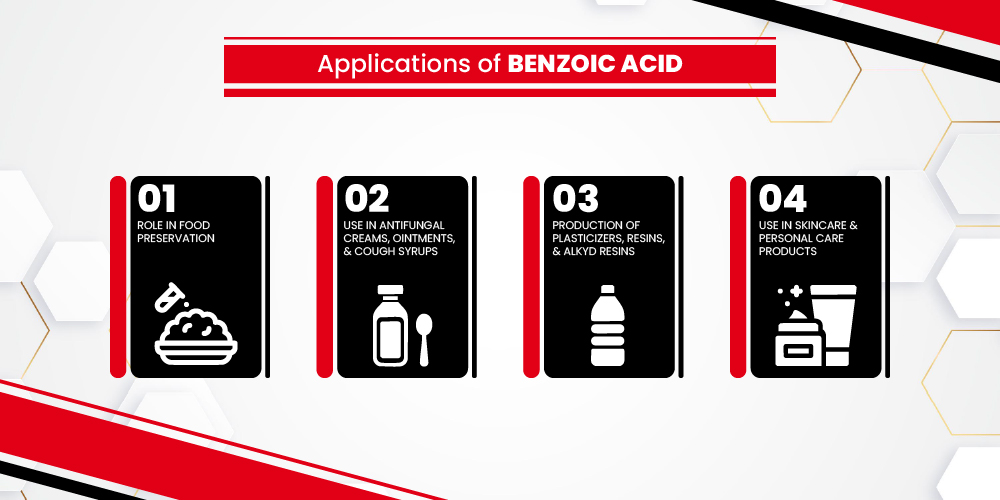From Food to Industry: The Versatile Applications of Benzoic Acid - Annexe Chem Pvt Ltd
From Food to Industry: The Versatile Applications of Benzoic Acid

- January 13, 2025
- By Akshita Patel
Did you know that a simple compound found in berries and certain plants plays a vital role in preserving the food we eat, the medicines we rely on, and even the cosmetics we use every day? Meet benzoic acid—a versatile organic compound that seamlessly bridges the gap between nature and industry. From keeping your favorite soda fresh to forming the backbone of complex chemical processes, benzoic acid is an unsung hero of modern life. But what makes it so indispensable? Let’s dive into the fascinating world of benzoic acid and uncover its chemistry, applications, and why it matters more than you think.
What is Benzoic Acid?
Benzoic acid is a naturally occurring organic compound belonging to the class of aromatic carboxylic acids. Recognized for its simple yet impactful structure, it plays a vital role in various industries, from food preservation to pharmaceuticals. The compound owes its name to benzoin resin, from which it was first derived. Today, benzoic acid is both synthesized and sourced from natural origins, making it a cornerstone of organic chemistry.
Chemical Formula and Structure of Benzoic Acid
Benzoic acid is represented by the chemical formula C₆H₅COOH. Its structure consists of a benzene ring attached to a carboxyl group (-COOH), giving it both aromatic and acidic characteristics. This dual nature contributes to its versatility in chemical reactions and applications.
Physical Properties of Benzoic Acid
- Appearance: Benzoic acid typically appears as white, crystalline solid flakes or powder.
- Odor: It has a faint, pleasant aroma.
- Melting Point: Approximately 122°C (252°F), where it transitions from solid to liquid.
- Boiling Point: Around 249°C (480°F), though it tends to sublimate when heated.
- Solubility: Benzoic acid is sparingly soluble in water at room temperature but becomes significantly more soluble in hot water. It dissolves readily in organic solvents such as ethanol, ether, and chloroform.
Key Chemical Properties of Benzoic Acid
- Acidic Nature: As a carboxylic acid, benzoic acid readily donates protons, making it a weak acid in water. Its pKa value of approximately 4.2 reflects its ability to ionize in aqueous solutions.
- Reactivity with Bases: Reacts with bases like sodium hydroxide (NaOH) to form water-soluble salts, such as sodium benzoate. This property is widely exploited in the food industry for preservation purposes.
- Ester Formation: Benzoic acid reacts with alcohols in the presence of acid catalysts to form esters. These esters, such as methyl benzoate, are used in fragrances and flavoring agents due to their pleasant smell.
- Substitution Reactions: The aromatic benzene ring in benzoic acid undergoes electrophilic substitution reactions, making it useful in organic synthesis for creating derivatives.
In summary, benzoic acid’s combination of physical and chemical properties makes it a multifaceted compound, indispensable in industries ranging from food preservation to chemical manufacturing.

Applications of Benzoic Acid
Benzoic acid’s versatility lies in its ability to enhance product stability, regulate acidity, and act as a key intermediate in chemical reactions. Its wide range of applications spans food, pharmaceuticals, industrial manufacturing, and cosmetics, making it a cornerstone of multiple industries.
Role in Food Preservation (E210 Additive): Benzoic acid and its sodium salt, sodium benzoate, are widely used as preservatives in the food and beverage industry. Known as additive E210, benzoic acid inhibits the growth of molds, yeasts, and certain bacteria, ensuring the longevity and safety of consumable products. Its effectiveness is most pronounced in acidic conditions, making it ideal for preserving acidic foods.
Common Products Containing Benzoic Acid
- Sauces and Condiments: Keeps ketchup, salad dressings, and soy sauce fresh.
- Jams and Jellies: Prevents microbial growth, maintaining texture and flavor.
- Soft Drinks and Beverages: Extends shelf life while preserving taste and quality.
Health and Safety Regulations while using Benzoic Acid
Regulatory authorities such as the FDA and EFSA have established strict guidelines for the use of benzoic acid in food products. Safe consumption levels are capped at 0.1% by weight in most products. While generally recognized as safe (GRAS), overexposure can lead to mild allergies or sensitivities in some individuals.
Use in Antifungal Creams, Ointments, and Cough Syrups: Benzoic acid’s antifungal properties make it a valuable ingredient in topical treatments for fungal infections, such as athlete’s foot and ringworm. Additionally, it is used in cough syrups and expectorants to aid in respiratory relief.
Importance in Formulations as a pH Regulator
In pharmaceutical formulations, benzoic acid serves as a pH regulator, ensuring the stability and efficacy of active ingredients. Its ability to maintain a controlled acidic environment prevents microbial growth and enhances the shelf life of medicines.
Production of Plasticizers, Resins, and Alkyd Resins: Benzoic acid is a crucial component in manufacturing plasticizers, which impart flexibility to plastics. It is also used in producing resins and alkyd resins, essential in coatings, adhesives, and varnishes. These applications make it indispensable in industries like automotive, construction, and packaging.
Intermediate in Organic Synthesis
As a building block in organic synthesis, benzoic acid is employed to create numerous derivatives, including benzoyl chloride, benzoates, and esters. These derivatives find applications in producing dyes, fragrances, and pharmaceutical compounds.
Use in Skincare and Personal Care Products: Benzoic acid is a common ingredient in skincare and personal care products, such as moisturizers, shampoos, and deodorants. It helps preserve the product’s integrity and prevents contamination.
Benefits as a Preservative and pH Adjuster
- Preservative: Extends the shelf life of cosmetic products by inhibiting microbial growth.
- pH Adjuster: Maintains the optimal pH for product stability and skin compatibility.
Benzoic acid’s adaptability across multiple sectors highlights its importance in both everyday products and specialized applications. From keeping food fresh to ensuring the quality of industrial materials and personal care items, its contributions are integral to modern life.
Health Effects and Safety Concerns
While benzoic acid plays a vital role in various industries, its use must be managed carefully to ensure safety for both consumers and workers. Understanding its safe consumption levels, potential allergic reactions, and proper handling procedures is key to minimizing risks associated with this compound.
Safe Consumption Levels and Exposure Limits:
- In Food and Beverages: Regulatory agencies such as the FDA and EFSA have established safe limits for benzoic acid in food products, typically capped at 0.1% by weight. This ensures that its preservative benefits are achieved without posing health risks to consumers.
- Occupational Exposure: For workers handling benzoic acid in industrial settings, agencies like OSHA recommend exposure limits to minimize inhalation or skin contact. Adequate ventilation and protective equipment are essential.
Possible Allergic Reactions or Sensitivities
In Consumers: While generally recognized as safe (GRAS), some individuals may experience mild allergic reactions or sensitivities to benzoic acid. Symptoms can include:
- Skin irritation, such as rashes or redness.
- Respiratory discomfort, especially in individuals with asthma.
- Gastrointestinal discomfort when consumed in large quantities.
In Workers: Direct contact with benzoic acid powder or solutions may lead to skin or eye irritation. Prolonged exposure without proper protection could cause respiratory issues.
Recommendations for Handling Benzoic Acid
Industrial Settings:
- Protective Equipment: Always wear gloves, goggles, and face masks when handling benzoic acid in its raw form.
- Ventilation: Ensure proper ventilation systems are in place to prevent the accumulation of benzoic acid fumes or dust.
- Storage: Store in a cool, dry, and well-ventilated area, away from heat sources and incompatible materials like strong oxidizers.
Domestic Use:
- In Food Products: Check ingredient labels for benzoic acid (E210) or sodium benzoate (E211) if you have known sensitivities.
- Cosmetic Products: Perform a patch test before using products containing benzoic acid, particularly for individuals with sensitive skin.
By adhering to these safety guidelines and being mindful of exposure levels, benzoic acid can be safely utilized in its many applications, contributing to enhanced product quality and consumer safety.
Benzoic acid is a truly versatile compound with applications spanning food preservation, pharmaceuticals, industrial processes, and cosmetics. Its unique chemical properties and adaptability make it indispensable in modern life, helping to ensure the quality, safety, and longevity of countless products we use daily.
At Annexe Chem Pvt. Ltd., we take pride in being one of India’s leading manufacturers of benzoic acid. With our state-of-the-art facilities and stringent quality control measures, we deliver high-purity benzoic acid tailored to meet the diverse needs of industries. Our commitment to sustainability and customer satisfaction drives us to provide innovative solutions and exceptional service. As we continue to explore the potential of benzoic acid, I’m confident that our dedication to quality and safety ensures that we’re contributing meaningfully to industries worldwide. Whether it’s keeping your favorite foods fresh or advancing industrial processes, benzoic acid is a remarkable compound that bridges nature and innovation—and we’re honored to play a leading role in its production.

Akshita Patel
As an advocate for sustainability, Akshita is committed to driving positive change within the chemical industry. She actively seeks out environmentally friendly solutions and promotes the adoption of sustainable practices. Akshita believes that a balance between economic growth and ecological responsibility is crucial for the industry's long-term success. She is dedicated to finding innovative ways to minimize environmental impact while maximizing efficiency and profitability.
Related Blogs

- May 27, 2025
- By Akshita Patel
Why Ferrous Sulphate Heptahydrate Is Essential.
Ever come across a bluish-green crystalline powder in a lab or industrial setup and wondered what.

- February 7, 2024
- By Akshita Patel
Magnesium Gluconate: Your Daily Source Of.
The chemical structure of magnesium gluconate is C12H22MgO14. Magnesium gluconate is a form of magnesium supplement.



